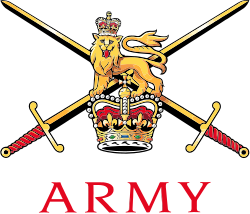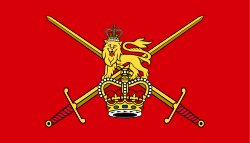
Back Britse Leër Afrikaans الجيش البريطاني Arabic Britaniya Ordusu Azerbaijani Британска армия Bulgarian British Army Breton Exèrcit britànic Catalan سوپای بەریتانیا CKB Britská armáda Czech Y Fyddin Brydeinig Welsh British Army Danish
| British Army | |
|---|---|
 Badge of the British Army[1]  Logo since 2018[2] | |
| Founded | 1 April 1707[3][4][note 1] |
| Country |
|
| Type | Army |
| Role | Land warfare |
| Size |
|
| Part of | British Armed Forces |
| March | List of marches of the British Army |
| Equipment | List of equipment of the British Army |
| Website | www |
| Commanders | |
| Head of the Armed Forces | King Charles III |
| Chief of the General Staff | General Sir Roland Walker |
| Deputy Chief of the General Staff | Lieutenant General David Eastman |
| Army Sergeant Major | Warrant Officer Class 1 John Miller[7] |
| Insignia | |
| War flag |  |
| Non-ceremonial flag |  |
 |
| British Army of the British Armed Forces |
|---|
| Components |
| Administration |
| Overseas |
| Personnel |
| Equipment |
| History |
| Location |
| United Kingdom portal |
The British Army is the principal land warfare force of the United Kingdom of Great Britain and Northern Ireland. As of 1 January 2025,[update] the British Army comprises 73,847 regular full-time personnel, 4,127 Gurkhas, 25,742 volunteer reserve personnel and 4,697 "other personnel", for a total of 108,413.[8]
The British Army traces back to 1707 and the formation of the united Kingdom of Great Britain which joined the Kingdoms of England and Scotland into a single state and, with that, united the English Army and the Scots Army as the British Army.[9][10] The English Bill of Rights 1689 and Scottish Claim of Right Act 1689 require parliamentary consent for the Crown to maintain a peacetime standing army.[11] Members of the British Army swear allegiance to the monarch as their commander-in-chief.[12] The army is administered by the Ministry of Defence and commanded by the Chief of the General Staff.[13]
At its inception, being composed primarily of cavalry and infantry, the British Army was one of two Regular Forces (there were also separate Reserve Forces) within the British military (those parts of the British Armed Forces tasked with land warfare, as opposed to the naval forces),[14] with the other having been the Ordnance Military Corps (made up of the Royal Artillery, Royal Engineers, and the Royal Sappers and Miners) of the Board of Ordnance, which along with the originally civilian Commissariat Department, stores and supply departments, as well as barracks and other departments, were absorbed into the British Army when the Board of Ordnance was abolished in 1855. Various other civilian departments of the board were absorbed into the War Office.[15][16][17]
The British Army has seen action in major wars between the world's great powers, including the Seven Years' War, the American Revolutionary War, the Napoleonic Wars, the Crimean War and the First and Second World Wars. Britain's victories in most of these decisive wars allowed it to influence world events and establish itself as one of the world's leading military and economic powers.[18][19] Since the end of the Cold War, the British Army has been deployed to a number of conflict zones, often as part of an expeditionary force, a coalition force or part of a United Nations peacekeeping operation.[20]
- ^ "The official Army badge". defenceimagery.mod.uk. Ministry of Defense. 31 December 2007. Archived from the original on 23 September 2024. Retrieved 23 September 2024.
- ^ "Army Briefing Note 19/18: The Army Brand" (PDF). armysportcontrolboard.com. British Army. 9 February 2018. Archived from the original (PDF) on 23 September 2024. Retrieved 23 September 2024.
- ^ Clifford Walton (1894). History of the British Standing Army. A.D. 1660 to 1700. Harrison and Sons. pp. 1–2.
- ^ Noel T. St. John Williams (1994). Redcoats and courtesans: the birth of the British Army (1660–1690). Brassey's. p. 16. ISBN 9781857530971.
- ^ Cite error: The named reference
Chandler2003was invoked but never defined (see the help page). - ^ a b c "Quarterly service personnel statistics 1 January 2025". Ministry of Defence. Retrieved 3 March 2025.
- ^ "Soldier Magazine April 2025". British Army. Retrieved 4 April 2025.
- ^ "Quarterly service personnel statistics 1 January 2025". gov.uk. 3 March 2025.
- ^ Williams, Noel T. St John (1 January 1994). Redcoats and courtesans: the birth of the British Army (1660–1690). Brassey's (UK). pp. 1–2. ISBN 9781857530971.
- ^ Walton, Clifford (1 January 1894). History of the British Standing Army. A.D. 1660 to 1700. Harrison and Sons. p. 16.
- ^ "Bill of Rights 1689". UK Parliament. Archived from the original on 12 March 2017. Retrieved 9 March 2017.
- ^ "Commanding Officers Guide. Manual of Service Law (JSP 830, Volume 1, Chapter 18)" (PDF). Archived (PDF) from the original on 8 October 2015.
- ^ cgsmediacomma-amc-dig-shared@mod.uk, The British Army. "The British Army – Higher Command". army.mod.uk. Archived from the original on 28 January 2017. Retrieved 9 March 2017.
- ^ "Naval and Military Pensions and Grants". Parliamentary Debates (Hansard). 12 February 1917.
- ^ "Department of the Master-General of the Ordnance – Regiment History, War & Military Records & Archives". forces-war-records.co.uk.
- ^ "Board of Ordnance – Naval History Archive". navalhistoryarchive.org.[permanent dead link]
- ^ Leslie, J. H. (1925). "The Honourable the Board of Ordnance. 1299—1855". Journal of the Society for Army Historical Research. 4 (17): 100–104. JSTOR 44220102.
- ^ Louis, William Roger; Low, Alaine M.; Porter, Andrew (2001). The Oxford History of the British Empire: The nineteenth century. Oxford University Press. p. 332. ISBN 978-0-19-924678-6.
- ^ Johnston, Douglas; Reisman, W. Michael (2007). The Historical Foundations of World Order: The Tower and the Arena. Brill. p. 508. ISBN 978-90-474-2393-5.
- ^ cgsmediacomma-amc-dig-shared@mod.uk, The British Army. "The British Army – Operations and Deployments". army.mod.uk. Archived from the original on 28 January 2017. Retrieved 9 March 2017.
Cite error: There are <ref group=note> tags on this page, but the references will not show without a {{reflist|group=note}} template (see the help page).
© MMXXIII Rich X Search. We shall prevail. All rights reserved. Rich X Search